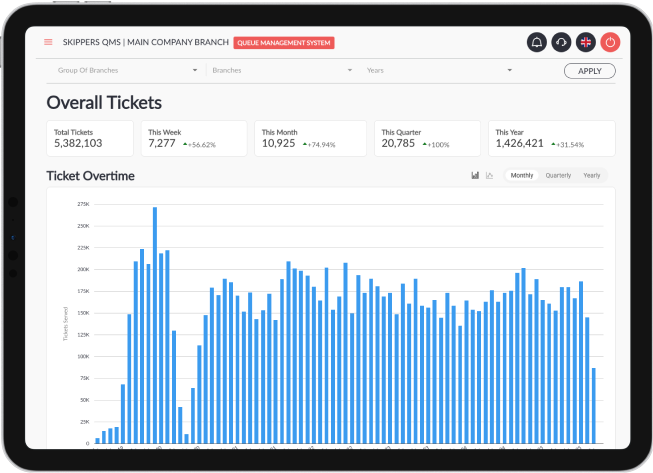Quick Fixes for Your Queue Management System

14 Aug 2025
Introduction
A good queueing management system keeps businesses organized and running smoothly. When it works, it helps employees focus, shortens waiting times, and helps customers feel taken care of. But when things shut down or glitch, it can throw everything off. Staff scramble, customers get annoyed, and the whole day feels out of sync.
Whether you’re using a system for appointments, walk-ins, or both, technical issues can pop up out of nowhere. Maybe screens aren’t showing updates, the app isn’t syncing, or data isn’t flowing like it should. Whatever the case, the goal is to get things moving again fast. The good news is most problems have quick fixes that can be handled without diving into complicated setups. Let’s look at how to spot what’s wrong and what you can do about it.
Spot the Signs Early
When a queueing management system goes offline or misbehaves, you don’t always get a loud alert. Sometimes, it’s the smaller, more frustrating signs that pop up first. A delay in syncing data, broken screen displays, or customers not receiving their turn notifications can create issues long before the system fully crashes.
Here are some common red flags to watch for:
- Bookings aren’t updating or showing up in real time
- Customers say they didn’t get text or email notifications
- Staff can’t access the latest version of the daily queue
- Kiosks or check-in stations stop responding
- Queues suddenly reset or disappear without explanation
If any of these issues sound familiar, it may mean the system is temporarily disconnected, overloaded, or dealing with a back-end issue. Not every problem will hit all users at once. It could just be one station or one feature glitching. That’s why catching the signs early makes a big difference.
Some problems have simple explanations. A short power outage might disrupt your screen display without affecting the database. A weak Wi-Fi signal might block updates from reaching mobile devices. Even a routine software update that didn’t finish installing could leave things buggy.
Before calling for outside help, it’s good to understand what the problem looks like. Pinpointing which part of the system is acting up can make it easier to respond fast. Once you’ve spotted where it’s slowing down, the next step is trying some basic troubleshooting.
Quick Troubleshooting Steps
When your queueing management system drops offline or misfires, don’t panic. Quite often, the fix starts with checking the basics. In many cases, a simple reset or adjustment can get things rolling again without having to call in outside support.
Try these steps to reboot normal operations:
1. Restart the system
Power off the system or affected devices completely for a minute or two. Then restart them to clear out temporary bugs.
2. Check the internet connection
Confirm that Wi-Fi is active and stable. If using multiple stations or devices, check each one’s connection individually to see if it’s a local or system-wide issue.
3. Look at hardware connections
Double-check outlets, monitors, and printers. Loose cables or faulty adapters could be the culprit, especially for check-in kiosks or display screens that look powered off.
4. Make sure everything’s logged in
Sometimes, the session times out or logs out due to a timeout setting. Make sure all staff and admin accounts are properly logged in.
5. Check time and date settings
Queue systems depend on accurate clocks. If a device gets out of sync, that can throw off appointment data, reminders, or service timing.
6. Rule out software updates
Look for signs of a pending system or device update. If the software isn’t current, that can cause slowdowns or unexpected bugs.
Running through these steps doesn’t take long and can stop a small issue from growing into a major disruption. If you make it through this list and the problem still isn’t solved, then it’s time to dig into help options like system support or backup solutions.
Use Support Resources When Troubleshooting Isn’t Enough
When a reboot or connection check doesn’t fix your queueing management system, it’s time to bring in backup, but that doesn’t always mean calling someone right away. Most platforms have built-in support options you can tap into before reaching for the phone. These can help get your service running without a long wait or technical back-and-forth.
Start with any built-in help sections or user tutorials. These often answer common questions about login problems, activity syncing, or system misfires. If your platform has a search function, try entering a few keywords related to what you’re seeing like “appointment schedule not showing” or “notifications delayed.” You might find a simple fix you hadn’t tried yet.
Another solid step is checking whether your system needs a software update. Many platforms push updates automatically, but sometimes they delay or fail. If anything looks out of date, make sure updates are allowed on your devices and restart afterward.
Support forums, if available, can also be helpful. People often post issues they’ve run into themselves, and you’ll likely come across posts that mirror your situation. Be sure to double-check the date on any advice to avoid applying an outdated fix.
If those routes don’t solve the issue, reach out directly to customer support. Send screenshots or error messages if possible, since clear details can shorten the time it takes to resolve the problem. Whether you call or message, having basic information like device names, your most recent actions, and observed symptoms ready will speed up the process.
Temporary Fixes To Keep Operations Going
While your system is down, business doesn’t hit pause. You still need ways to organize customer flow and keep things moving, even if it’s just for a short time. That’s where temporary fixes come in handy. They’re not meant to replace your main queueing system, but they can help you stay on track while a solution is being worked on.
Here are a few practical ideas for temporary setups:
- Use pen and paper sign-ins at the front desk. Keep customers in order using timestamps
- Set up a printed sign-in sheet with time slots and key service categories
- Assign a staff member to manually manage flow and notify customers in person
- Use customer phone numbers to text them updates on their spot in line
- Communicate wait times clearly in writing on a whiteboard or screen, if available
These backup steps can be simple but still work well for short-term service. Let customers know what’s going on. Most people will understand if you’re clear, proactive, and polite.
One clinic, for example, used sticky notes and a dry-erase board when its digital platform went down during peak hours. While it wasn’t ideal, patients appreciated the effort to stay organized and informed until things were rebooted. It wasn’t fancy. It just worked.
Tips To Prevent Queueing System Downtime
Dealing with system issues is frustrating, but most tech troubles leave behind a learning opportunity. The best way to limit problems in the future is to prepare for them now while things are running smoothly.
Start with basic routine care. Check your devices, software, and internet connections at regular intervals. Clear cache data where needed, and check that automatic updates are on. Reboots during off-hours can help your system stay clear of glitches that build up over time.
Staff training is just as important. Make sure your team knows how the queueing features work and what actions to take when issues pop up. A shared checklist or cheat sheet can help new employees learn quicker and avoid mistakes that lead to downtime.
Talk about backup plans ahead of time, not when things start breaking. Decide as a team what steps to follow for power cuts, Wi-Fi outages, and log-in problems. When everyone’s on the same page, the business won’t lose time trying to figure out who should do what.
Don’t forget about data backups. Regular backups help save records and logs, and they give peace of mind when systems go offline. Whether stored online or locally, keeping past queue data safe means you won’t lose track of your service history or schedules.
Keeping Queues Flowing With Less Stress
A downed queueing management system can feel like a roadblock, but it doesn’t have to derail your entire day. With a clear-eyed look at the issue, a few quick resets, and temporary process swaps, you can keep customers moving even if your main system doesn’t want to cooperate. Knowing how to spot problems early and tackle them step by step makes a big difference.
Over time, consistent care, smarter team prep, and using resources when needed all help prevent system hiccups before they begin. When your tools are strong and your backup plans are ready, handling tech troubles stops being a guessing game and starts feeling like just another thing you’re prepared to handle.
Wrap up your efforts to keep your systems running smoothly by exploring how Skiplino can support your business with a reliable queueing management system. With our expertise, you can ensure that customer flow remains uninterrupted, even when technical issues arise. For more on how we can help streamline your operations and reduce downtime, connect with our team today.
Latest



Similar Reads

All Rights Reserved @2025 Skiplino Technologies WLL.




